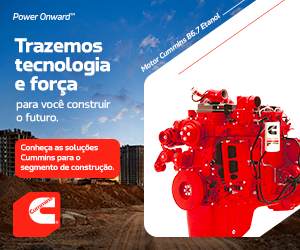Sugar mills prepare fleet for upcoming harvest
 Federal Government projections indicate growth in yield for the sugarcane crop to be harvested in 2013, causing producers of sugar and ethanol to painstakingly prepare mobile equipment to ensure the utmost in productivity during planting and harvesting of the season’s crop
Federal Government projections indicate growth in yield for the sugarcane crop to be harvested in 2013, causing producers of sugar and ethanol to painstakingly prepare mobile equipment to ensure the utmost in productivity during planting and harvesting of the season’s crop
Between December and January (the period during which this article was prepared), sugarcane mills in Brazil’s Southeast region - the largest producer of sugarcane in the country (see box on p. 14) - were in the offseason. The period, at first glance unproductive, was deliberately chosen by the reporting staff of M&T Magazine to look into a process which is less noticeable in the sugar and ethanol market, but is extremely important for sugar mills: the process of maintenance of equipment used in planting and harvesting. Inaugurating coverage of a new segment in the publication, you - our reader - can learn on the following pages how companies take advantage of the offseason to prepare their fleets of machines for the next harvest by accompanying the experience of ‘Usina Ester’ - one of the oldest sugar mills in operation in Brazil.
Before that, it is worth remembering that the forecast for the next harvest season is that there will be a significant increase in crop yield, which means an even greater need to fine tune the maintenance of equipment that, if projections hold true, will be deployed with even greater intensity in 2013.
This is apparent in the statistics released by the ‘Companhia Nacional de Abastecimento’ (CONAB - National Food Supply Company) linked to Brazil’s Ministry of Agriculture, Ranching and Supply. For each crop, CONAB conducts three surveys forecasting yields and planted area for various sectors of agriculture, among which sugarcane is included. For the 2012/2013 harvest season, the government company’s survey suggests an estimated total production of 595.13 million tons of sugarcane, which means an increase of 6.2% compared to the previous season’s harvest which was 560.36 million tons. With that, the country remains the world's largest producer of this agricultural commodity.
Mechanization
 At Usina Ester, the next harvest is awaited with great attention. Located in the countryside of São Paulo state, more precisely in the city of Cosmopolis (near the city of Americana), the company opened its machine shop to show how it performs the maintenance of its harvesters, loaders, tractors, trucks and other mobile equipment used in harvesting and planting sugarcane. “Today, we work with 85% of the harvest done mechanically and we are also beginning to mechanize the planting of sugarcane, which requires us to have a fleet of reliable equipment to perform these operations,” explains Marcos Rossine Jr., manager of the sugar mill’s farming operations.
At Usina Ester, the next harvest is awaited with great attention. Located in the countryside of São Paulo state, more precisely in the city of Cosmopolis (near the city of Americana), the company opened its machine shop to show how it performs the maintenance of its harvesters, loaders, tractors, trucks and other mobile equipment used in harvesting and planting sugarcane. “Today, we work with 85% of the harvest done mechanically and we are also beginning to mechanize the planting of sugarcane, which requires us to have a fleet of reliable equipment to perform these operations,” explains Marcos Rossine Jr., manager of the sugar mill’s farming operations.
In harvesting for grinding, the degree of mechanization achieved by Usina Ester is higher than the level found in the state of São Paulo where, on the average, the mechanization of harvesting reached 81% in 2012 - the highest rate in the country. This record high for the Usina Ester stems from the milling of 1.8 million tons of sugarcane by the company last year. This amount was harvested from an area of 22,000 hectares of its own or leased farms, and from outsourced suppliers. “On all this land, the only places where harvesting is not mechanized are regions with slopes of 18%, uphill or downhill, where mechanical harvesters are unable to operate,” explains José Ribeiro Netto - Human Resources Manager at Usina Ester.
According to Ribeiro Netto, such sites are usually harvested manually with sugarcane in the raw, leaving a residual amount which is burned within the parameters established and regulated by the Ministry of Agriculture, Ranching and Supply. “Our preference for a mechanized harvest is justified in the numbers,” says the manager. “In the manual process, the cost of cutting, carrying and transport (CCT) is around R$ 36,00 (US$ 18.00) per ton, while with the use of mechanization the cost drops to R$ 21,00 (US$ 10.50).”
To achieve such a high rate of mechanization, Usina Ester relies on a fleet of 17 cane harvesters; 13 of their own and the remainder belonging to suppliers. “For our own fleet, we decided to standardize and use just one brand of harvester, which facilitates maintenance as regards the replacement of parts and even the training of mechanics and operators,” says Rossine. At Usina Ester, all the machines in use are John Deere brand.
Maintenance
 In operation, each harvester chops around 600 tons of cane per day, which are transported by 57 sugarcane trucks - also divided between the mill’s own fleet and service providers. “These are trucks of the road-train type (30 meters long), in the power range of 400 hp, and carry 55 tons of cane each,” explains Rossine in sizing up the fleet that operates under his management.
In operation, each harvester chops around 600 tons of cane per day, which are transported by 57 sugarcane trucks - also divided between the mill’s own fleet and service providers. “These are trucks of the road-train type (30 meters long), in the power range of 400 hp, and carry 55 tons of cane each,” explains Rossine in sizing up the fleet that operates under his management.
To ensure high productivity, the harvesters go through systematic maintenance during the offseason. Rossine tells us that this type of equipment suffers high wear during operation, mainly as refers to the machine’s cutting components or those parts that have direct contact with sugarcane leaves. “The mixture of mineral and plant impurities (present in the sugarcane leaves and soil) constitutes a highly abrasive material, causing excessive wear to harvesters,” he states. “This means that, at the time of every offseason, our maintenance crews must disassemble these machines almost entirely in order to recover wear plates and equipment chassis by welding, in addition to replacing cutting implements and even performing corrective or preventive maintenance of hydraulic and mechanical components.”
Usina Ester has a maintenance tracking system that generates data on the service life of free-standing component assemblies such as the engine, transmission and aggregate components. However, the maintenance of these items is fully outsourced since, according to Rossine, there is no longer any need to maintain a specialized team on duty and incur the high cost of purchasing tools to perform the work in our own garage. “In the past, all maintenance work was done here and that meant bearing high costs,” he says. “Today, with suppliers that are increasingly structured, it is no longer worthwhile to centralize these processes.”
Preventive maintenance on the other hand, such as lubrication and replacement of air filters and oil, is performed right there in the shop. There, you have specific tools for tire repair and welding services. “Among mechanics and helpers, we have a staff of 85 repair shop professionals, but, as in any market, we have trouble holding on to this staff permanently,” says Ribeiro Netto.
Qualification
That difficulty led the company to create a training program in cooperation with SENAI (Serviço Nacional de Aprendizagem Industrial - National Service for Industrial Apprenticeship ). By mid-April the first class in the qualification program will be formed with 16 mechanics; all hired by the plant itself in anticipation as assistants. The apprentices will assume the role of mechanics as soon as they conclude the training process, which includes a practical and theoretical curriculum. “The next steps are the training of operators and more mechanics,” says the HR manager.
To Rossine, the conservation of equipment does in fact demand both the training of operators as well as qualified mechanics. After all, machines as specific as harvesters require careful and criteria-based operation. Exemplifying, he cites the sensitivity required of the operator to keep the harvester’s crop divider scrolls - a kind of mill positioned in front of the harvester which serves to lift and feed the cane into the machine - just slightly above the ground. “If the divider is constantly left in contact with the ground, it will suffer premature wear and, consequently, will have a much shorter service life,” he explains.
Processes
To understand how the use of harvesters is critical, it is worthwhile to provide details on how they work: harvesters move alongside, flush with the planted crop while their two base-cutter discs cut the base of the cane stalk, the other two topper discs cut the tips. Then, when the final destination is grinding, the harvester collects the cane stalks and chops them into billets with approximately 15 cm in length. However, if the objective of the harvest is the collection of cuttings for subsequent planting, the cutting machine should be adjusted to provide longer cuttings of up to 50 cm in length.
In the case of planting, the process of harvesting requires other adaptations. The harvester gets rolls that are coated along their entire inside surfaces in order to protect the seedlings from contact with these parts of the equipment. According to Rossine, the way the stalk is cut must also be different so that the “bud” of the seedling is not damaged. In addition, so as to get longer cuttings, adjustments are also made in the distance between the harvester’s inside cutter knives.
Whether for grinding or planting, mechanical harvesting of sugarcane generates straw (dry leaf material) which is blown away by the harvester itself and ends up covering up the plot. In part, the sugarcane straw is loaded and carried along with the cane to be used as a source of energy in cogeneration, while the rest remains left upon the soil.
Cane that is cut manually represents 15% of the sugar mill’s crop and is loaded onto trucks using loaders. Usina Ester’s fleet has eight loaders which, one does well to point out, do not look anything like the loaders that are used by the markets of construction and mining. “These machines have wheels and are equipped with claws on the end of their booms to lift the harvested material up to 5 meters and dump it into the bed of the truck,” Rossine says.
Getting back to the subject of mechanization, immediately after cutting, the sugarcane is transported from inside the harvester by a conveyor lift and falls right into a hopper - a box on wheels hooked up to a tractor - to transport cane to where the road-trains are awaiting to receive the load. Generally, this location is referred to as the “point of load transfer”, from which the road trains proceed with their cargoes to the grinding site.
To provide assistance at each work front, the Usina Ester sugar mill has a maintenance truck equipped with welding machines for small interventions in its harvesters’ cutting components, such as knives and discs, as well as components for performing preventive maintenance activities. In sugarcane cropping, in fact, air filters, oil filters and motor oil are replaced on an almost daily basis because, although sugarcane harvesting operations and transportation seem simple, they are rough on equipment. In the case of harvesters, straw mixes with soil from crop field plots and accumulates in the undercarriage and in the internal compartments of the machines. “Therefore, cutting equipment, such as knives and internal cutters (choppers) that are used to chop the cane, often display marked wear, which means there is a need for systematic and usual repairs,” explains Rossine.
Preparation
As previously mentioned in this article, Usina Ester will also begin to employ mechanical harvesting for the collection of cuttings for planting. But that procedure characterizes only one part of the mechanization of planting which also involves the preparation of the plot of land and the actual placing of the cuttings in their furrows.
At Usina Ester as well as in much of the country's sugar and ethanol production sector, the soil is tilled mechanically starting with terracing (contour plowing) in which motor graders and bulldozers prepare terraces, with appropriate water run-off barriers, and roads enabling the traffic of planting and harvesting equipment as specified in topographical design.
The next step is the correction of soil in which agricultural tractors with attached trailers are used. The third step is harrowing in which remaining ratoons of old cane are eliminated allowing a new planting to be carried out efficiently. Lime, which corrects the chemical characteristics of the soil, is also applied at this stage in which fertilizers are also added.
The next stage involves the application of fertilization. To do so, the tractors are again equipped with special implements such as a furrow plow or the planter itself.
While Usina Ester is preparing to begin mechanization of the production process with harvesting, some sugar and ethanol mills are already at work on the mechanization of other stages of the process, such as planting. In such cases, the standard process is to transport the collected sugarcane cuttings to the work front where they are loaded into a device called a planter. Supplied by leading manufacturers of agricultural equipment, a planter consists of bins of various sizes that are drawn by tractors and deposit cane cuttings in the field at a preset distance along the furrows.
Learn about the structure of a sugarcane harvester:

1 Topper – cuts leaves the (straw) from the tops and the heart of the cane
2 Side trim knives disc – cuts the ends of tangled cane
3 Dividers (scrolls) – separate the row of cane being harvested from adjacent rows
4 Knockdown roller – tilts the cluster of sugarcane stalks to be cut
5 Feed roller – assists in feeding cane to the base cutter
6 Base cutter – cuts the cluster of cane stalks flush with the ground
7 Butt Lifter roller – lifts the stalks and guides them into the harvester
8 Roller train – guides the stalks to the chopper drums
9 Chopper drums – cut the cane into billets and pitches it into the primary extractor
10 Elevator Bowl – receives the billets that leave the chopper
11 Primary Extractor – cleans the billets
12 Rotating elevator – moves billets to the secondary extractor
13 Elevator slew table – rotates (turns) the elevator for unloading
14 Secondary extractor – performs second cleaning of the billets
15 Bin Flap – directs the unloading of sugarcane billets
16 Cab – location of harvester controls
17 Engine – provides mechanical power
18 Cooling System –radiators for intake air

Av. Francisco Matarazzo, 404 Cj. 701/703 Água Branca - CEP 05001-000 São Paulo/SP
Telefone (11) 3662-4159
© Sobratema. A reprodução do conteúdo total ou parcial é autorizada, desde que citada a fonte. Política de privacidade















